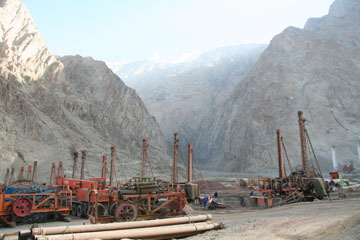China misses pollution targets
China misses pollution targets
mongabay.com
February 13, 2007
China’s environmental protection agency said that the country failed to meet any of its 2006 pollution control goals according to its web site. The State Environmental Protection (SEPA) admitted that economic growth actually caused the country to fall well behind its environmental targets.
China had hoped to cut sulfur dioxide emissions (SO2) and Chemical Oxygen Demand (COD), a water pollution index, by 2 percent in 2006. Instead, levels of both pollutants increased. Sulfur dioxide emissions increased nearly 463,000 tons, 1.8 percent higher than 2005, while COD reached 14.31 million tons, 173,000 tons, or 1.2 percent, more than in 2005. Fan Yuansheng, director of the pollution control department of the SEPA, said that China aims to reduce its SO2 and COD emissions by 3.2 million tons and 1.23 million tons this year, but SEPA itself concedes this is unlikely given economic growth forecasts for the country.
Last year when China’s economy grew by 10.7 percent, SEPA figures show that coal consumption increased by almost 230 million tons, resulting in the release of 2.8 million tons of sulphur dioxide from coal burning. SEPA estimates that if China’s economy grows by the predicted 9 percent this year, another 2.4 million tons of SO2 will be released into the atmosphere and COD will increase by 0.9 million tons.

|
Nevertheless, SEPA remains optimistic.
“We are optimistic that we can meet the target by taking a series of concrete measures,” Zhou Shengxian, SEPA minister, told a “green” conference in Beijing. SEPA says the government also plans to cut energy consumption per unit of gross domestic product by 20 per cent by 2010.
China, the world’s most populous country and fastest growing economy, faces a host of environmental problems. Energy and water shortages, water and air pollution, cropland and biodiversity losses, and escalating emissions of greenhouse gases are all concerns as the country moves towards world superpower status.
China has some of the world’s most polluted cities and waterways. A December 2005 report from the Chinese government said some 300 million Chinese drink unsafe water tainted by chemicals and other contaminants, while a nationwide survey found that about 90% of China’s cities have polluted ground water. Meanwhile, a 2005 study by the World Health Organization (WHO), reported that seven of the world’s ten most polluted cities are in China and almost two thirds of the country’s largest cities fail to meet the organization’s air quality standards. The World Bank estimates that pollution is costing the country 8-12% of its $1.4 trillion GDP in direct losses.
While these issues could threaten to destabilize the country and derail economic growth, it appears that it is taking steps to address some of these challenges.
In September 2006, the government proposed a plan to curb sulphur dioxide emissions through a trading scheme that would require power plants to pay for the right to emit the pollutant. China is the world’s largest sulphur dioxide polluter, emissions of which have climbed by some 27 percent to 25.5 million tons since 2001. Sulphur dioxide emissions are blamed for worsening acid rain which affects one-third of the country according to Sheng Huaren, deputy chairman of the Standing Committee of parliament.
The proposal came two months after China announced it would spend $175 billion protecting its environment over the next five years. The money will be used to reduce pollution, improve water quality, and cut soil erosion. The government has banned logging, spent $190 million on environmental protection along the new Golmud and Lhasa railway, initiated a reforestation project that would plant an area of forest the size of California, and invested billions in renewable energy technologies including wind, solar, and biofuels, setting a target of 12 percent of its power generation capacity coming from renewables by 2020 — up from a 3 percent in 2003. The government’s interest in reducing China’s use of petroleum products extends beyond environmental and health concerns; it sees both the strategic value of mitigating its reliance on foreign oil (currently about 10 percent of oil use) and the economic advantages of being on the technological leading edge of energy production. Nevertheless, the country is expected to become the world largest producer of carbon dioxide, a potent greenhouse gas, before 2020. The country, like the United States, has refused to any binding limits on emissions, though last week it announced plans to establish Asia’s first carbon-trading exchange, a sign that it may be preparing to take more action on emissions that are believed to responsible for global warming.
This article used quotes and information from the SEPA web site and previous mongabay.com articles.